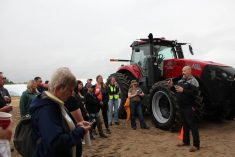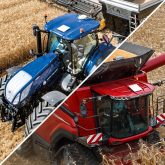Although it’s easy to be smitten with the latest precision agricultural technology, one expert in the field advises people to look before they leap when it comes to adopting the technological innovations on offer.
“Do your homework and know that the return on investment or the value of a technology on one farm is not going to be the same on another. Every farm is different, and every farm operates differently, and every farm value is different,” says Joy Agnew, associate vice-president of applied research at Olds College of Agriculture and Technology in Alberta.
“Every farm is different, and every technology will play a different role in a farm, so assessing that value for your farm is going to be a very unique thing. The rule of thumb would be to have a really good understanding of your current cost of production for certain things. Value often boils down to dollars and cents. You need to have a really strong understanding of where you’re at right now … so you can make a proper assessment of what value a new technology might bring you.”
Read Also

Claas brings 1000 Series SP forage harvesters to Canada
In mid-August, Claas unveiled its new line of Jaguar forage harvesters at an event in Visalia, California, deep in the heart of that state’s dairy region.
Agnew was a presenter at Saskatchewan Agronomy Research Update 2022, held last December in-person in Saskatoon and online. The two-day event brought together agronomists, producers, industry members and retail representatives to learn about what happened during the 2022 growing season and what to expect in 2023.
Agnew’s presentation focused on navigating agricultural tech and data utilization options and offered an overview of the latest precision ag technologies in use at the college’s Smart Farm, a 3,600-acre working farm designed to provide hands-on opportunities for learning and applied research.

Optical spot spraying
One of the current areas of focus at the Olds College Smart Farm is green-on-brown and green-on-green optical spot spraying. While it is one of the most mature technologies the Smart Farm has adopted, Agnew says many producers continue to have questions about its overall performance including its accuracy and its herbicide use reduction.
Recent testing conducted at the Smart Farm gave optical spot spraying a passing grade. Despite less-than-ideal weather conditions during those trials, testing showed it can reduce herbicide application by up to 97 per cent in spot mode and up to 26 per cent in bias (both spot and low-level broadcast) mode. Equally encouraging was the fact the customized 24-inch Hardi sprayer with a Weed-It Quadro system used appeared to have no negative effects on yield or weed pressure despite a substantial reduction in herbicide use.
“It works incredibly well for what it’s designed to do. We were pleased with how reliably it would detect and target and spray weeds,” says Agnew, adding that while reduced chemical use has been demonstrated in the past, the college’s testing was one of the first times the technology’s effect on yield was examined.
Despite the promise offered by optical spot spraying, Agnew says it may not be a good fit on some farms. That will depend largely on the specific use case and what a grower’s priorities are, she explains.

“There are specific use cases where it makes a lot of sense to invest in the technology, but if you don’t fall into that category and you don’t have the same use cases that others do, then maybe it’s not worth the investment. It’s a complex sort of economic or return on investment calculation that each individual farmer would have to do for themselves,” she says.
“What we’re trying to do is provide information on the overall functionality and performance to help (farmers) navigate some of those use cases and then (they must) crunch the numbers themselves to determine what it’s ultimately going to save them in terms of herbicide use.”
Soil nutrient sensors
Another form of precision ag technology that holds considerable promise, according to Agnew, is soil nutrient sensors. While some early versions weren’t very reliable, she says many newer models the college is working with have shown much more potential.
“They are very robust technologies that seem to be working well,” she explains. “They’re still developing some calibration coefficients and curves for specific soil types, but they work as advertised and are generating some pretty unique information … that farmers could use to make specific in-season management decisions if that aligns with their overall production practices.
“The potential for them is tremendous in that we’ll no longer need to be relying on a single composite sample for an entire field or even a zone. We’ll have the ability to measure soil nutrients in real time at a much higher density so that we’re a little more informed in our decisions.”
Agnew says soil sensors can be a useful tool for farmers looking for immediate or near-immediate soil nutrient profiling results in the field to develop a prescription map in conjunction with an agronomist or crop advisor. The sensors can also pay dividends to growers looking to apply a split nitrogen application including foliar nitrogen partway through the growing season, she adds.

Weather stations
It’s no secret one of the biggest determining factors in the success of a crop is weather. That probably explains the growing interest among many farmers in portable weather stations and a recent proliferation of different models from manufacturers.
The Olds College Smart Farm has tested a variety of different makes and models that provide farmers with a wealth of weather-related information, says Agnew. That includes information on everything from temperature, humidity and rainfall to solar radiation and even a normalized difference vegetation index (NDVI) to better understand vegetation density and changes in plant health.
Agnew says weather stations can be a valuable asset for growers looking to be more precise with in-season applications of pesticides, herbicides or fungicides.
“You can make a more precise decision rather than relying on a government-owned weather station that is located 30 miles away. You are able to make far more precise decisions for your specific field or fields,” she adds.

Real-time grain quality assessment
Another area of growing interest for farmers and others involved in the ag industry is real-time grain quality assessment. The Smart Farm recently tested a CropScan 3300H On Combine Grain Analyzer unit that analyzes grain just before it’s dumped into a hopper.
The unit measures several factors such as protein, oil, fibre, starch, colour and moisture content in grains and oilseeds as they are harvested in the field. The data that’s gathered is georeferenced and can provide a high-resolution map of the field. The unit was used in combination with a 2004 model John Deere 9660 combine, which shows you don’t need new equipment to make use of the latest technology.
“One of the things we discovered was it got a lot of agronomists and research agronomists extremely excited because it’s now giving them another layer of data they had never really been able to assess before in terms of tying agronomic principles to outcomes like protein content variability,” Agnew explains.
As promising as grain quality assessment technology may be, it does come with some challenges. The main one is the initial calibration process of the devices can be quite involved and time consuming.
“You have to know what you’re doing and follow the rules,” she adds.
Satellite imagery
Some out-of-this-world tech could soon have a big effect on the decisions farmers make at the field level. Olds College recently undertook a study on the use of satellite imagery to develop prescription maps for variable-rate fungicides and desiccants, a sector Agnew says is on the “cusp of an explosion” with the increasing availability of publicly available satellite imagery.

However, Agnew says it could be some time before satellite imagery is in common use on most farms. For one thing, it takes time to convert the data obtained from satellites into a usable map. It’s also not exactly user friendly at the moment.
“For the most part, you still have to have someone on your team who knows what they are doing,” Agnew says. “These aren’t really plug-and-play, push a button (devices) and boom here’s a map based on your satellite imagery. There’s still quite a bit of assessment and tweaking (needed).”
In-bin grain monitoring, drying
One area of precision ag technology that particularly interests Agnew is in-bin grain monitoring and drying. That includes everything from sophisticated monitoring units that can be used to create a 3D moisture map of the interior of a storage bin to simple, cost-effective devices that measure grain moisture in the bin.
“There’s a lot of exciting work taking place in that area,” Agnew says.
“Historically, in-bin drying has been a black box: you have grain in your bin, you turn on a fan, let it run however long you think it needs to run for and then you turn it off. There was really limited information that a farmer could access unless they’re climbing into a bin probing or pulling out the grain.”

Autonomous equipment
No discussion about precision ag technology would be complete without at least a passing reference to autonomous equipment. Agnew says Olds College decided to invest significantly in autonomous technology when it launched its Smart Farm five years ago due to continued high levels of interest, which the college determined was only going to increase in the coming years.
Olds College currently uses a Raven OmniPower platform for three field operations (seeding, spraying and spreading). It utilizes three implements including a SeedMaster 30-foot air seeder, a Pattison 120-foot sprayer and a New Leader 90-foot fertilizer spreader.
The college is in the third year of a three-year case study that is comparing conventional farm machinery with autonomous equipment. While the results won’t be known for some time yet, Agnew says preliminary findings have shown that autonomous equipment has a definite leg up on conventional apparatus in terms of field efficiency.
That includes optimizing a route plan or path, which helps improve overall field efficiency, she notes. The college’s initial results have shown that autonomous equipment can also boost productivity because farmers don’t have to be present during operation and are free to perform other tasks.
Agnew says the information provided by the case study could also go a long way in helping researchers to better gather and analyze data from engine efficiency in the field and wheel slippage within different topographic variations in a field.
“We’re opening the door to all kinds of new trend analysis and assessments of equipment operating within a field with the variability you see in a field.”
















